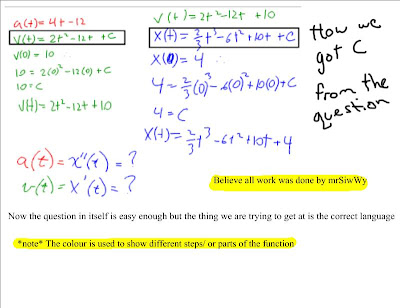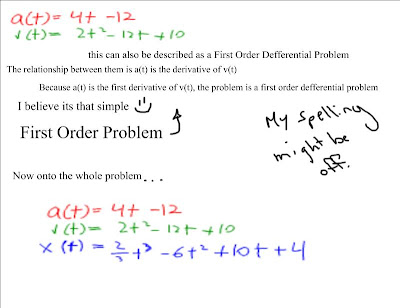The exam is over and we did a little survey in class. The results are below; 7 students participated. If you'd like to add another comment on what you see here
email me or leave a comment below this post.
Without any further ado, here are the results of our class's survey. Please share your thoughts by commenting (anonymously if you wish) below .....
Classroom EnvironmentThe questions in this section were ranked using this 5 point scale:
| Strongly Disagree | Disagree | Neutral | Agree | Strongly Agree |
| 1 | 2 | 3 | 4 | 5 |
The
bold numbers after each item are the average ratings given by the entire class.
1. The teacher was enthusiastic about teaching the course.
4.862. The teacher made students feel welcome in seeking help in/outside of class.
4.713. My interest in math has increased because of this course.
4.144. Students were encouraged to ask questions and were given meaningful answers.
4.575. The teacher enhanced the class through the use of humour.
4.436. Course materials were well understood and explained clearly by the teacher.
4.297. Graded materials fairly represented student understanding and effort.
4.298. The teacher showed a genuine interest in individual students.
3.719. I have learned something that I consider valuable.
4.8610. The teacher normally came to class well prepared.
4.43Overall Impression of the CourseThe questions in this section were ranked using this 5 point scale:
| Very Poor | Poor | Average | Good | Very Good |
| 1 | 2 | 3 | 4 | 5 |
1. Compared with other high school courses I have taken, I would say this course was:
4.572. Compared with other high school teachers I have had, I would say this teacher is:
5.003. As an overall rating, I would say this teacher is:
4.86Course Characteristics1. Course difficulty, compared to other high school courses:
Very Easy
0% | Easy
0% | Average
28.6% | Difficult
28.6% | Very Difficult
42.9% |
2. Course workload, compared to other high school courses:
Very Easy
0% | Easy
14.3% | Average
28.6% | Difficult
28.6% | Very Difficult
28.6% |
3. Hours per week required outside of class:
0 to 2
28.6% | 2 to 3
0% | 3 to 5
14.3% | 5 to 7
42.9% | over 7
14.3% |
4. Expected grade in the course:
AP Exam PreparationThe
bold numbers after each item are the average ratings given by the entire class.
How prepared were you to write this exam?
75.6%How much effort did you put into preparing for this exam?
73.1%How good a job did your teacher do preparing you for this exam?
90.1%Did you have enough preparation using your calculator?
Did you have enough preparation without using your calculator?
Was your teacher too hard or too easy on you?
Too Hard
0% | Too Easy
42.9% | Just Right
57.1% |
Specific Feedback[
Ed. Note: Numbers in parentheses indicate the number of students, over 1, that gave the same answer.]
What was your best learning experience in this course?
Enthusiasm, effort, and humour by the teacher (2)
Workshop classes
Pre-Tests (3)
Developing Expert Voices project
This blog
Everything except the Developing Expert Voices project
Teaching others and explaining concepts
Lectures
Exam Prep
Scribe posts were awesome
Technology
SMARTboard
Group learning |
What was your worst learning experience in this course?
Developing Expert Voices project (2)
Falling behind due to the fast progress of other classmates
Not being able to do homework in class
The wiki solutions manual
Lectures were not visual enough
When substitute teachers wouldn't let us talk to each other |
What changes would you suggest to improve the way this course is taught?
Return tests more quickly
Go over solutions to every test question always
Give regular "marks updates" so I know when I need to invest a lot or a little effort
Cancel the Developing Expert Voices project
More practice work for home posted to the blog
Cancel the wiki assignment
Slower explanations that hit all key points
Tell students how fast their Developing Expert Voices dues dates creep up on them
More group learning, I learned a lot in groups
Have a review class every couple of units |
It's interesting to compare the items that were considered both the worst and best learning experiences. Also, take a look at the list of worst learning experiences compared to suggestions for next year. Help me do a better job next year by commenting on what you see here ....
 We had our graduation exercises today. A gentle push into the world for all of you. I hope you're leaving with the keys to your future in your hand.
We had our graduation exercises today. A gentle push into the world for all of you. I hope you're leaving with the keys to your future in your hand.













































